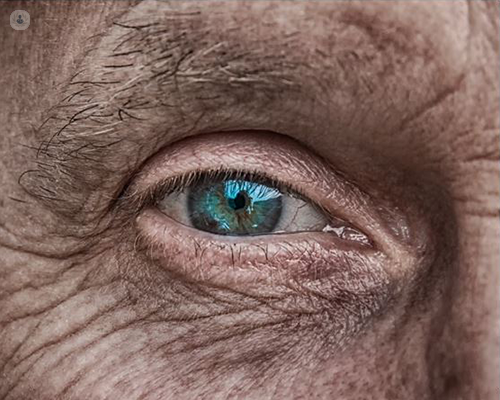Cataract surgery and types of artificial lenses explained
Written by:Cataract surgery is a very common procedure and its performed by ophthalmologists to restore a patient’s vision. During this procedure, an ophthalmologist will remove the natural lens from the eye and replace it with an artificial intraocular lens - ‘intraocular’ meaning inside the eye.

What is a cataract?
A cataract is a dirty or cloudy lens in the eye, which gives the person with the cataract the impression of misty vision.
Most often, this occurs as part of the ageing process and affects the elderly. However, other patient groups might develop cataracts earlier, such as people with diabetes.
To treat cataracts, an ophthalmologist will exchange the cloudy lens for a new one, and this new lens inserted into the eye will be an artificial intraocular plastic lens.
How do artificial intraocular lenses help people with cataracts?
The only way to improve vision loss obtained by cataracts is with surgery. In doing so, light can then fully enter the eye and reach the retina, allowing the patient to once again have a clear view.
The types of intraocular lenses: monofocal, multifocal and EDOF.
There are three different intraocular lenses (IOL) that can be recommended to patients: monofocal, multifocal and extended depth of focus (EDOF).
Monofocal IOL
The monofocal IOL is the standard lens usually given to patients. It provides clear vision at a distance only, and patients usually require reading glasses after it has been inserted.
Multifocal IOL
A multifocal IOL gives the recipient a good level of visibility at distance and up close without the need for reading glasses. This provides an advantage over the monofocal IOL.
However, multifocal lenses can have side effects such as glare and/or halos, which can be noted particularly when driving a car at night. A car headlight might look more star-shaped (glare) whereas halos are like rings around the car headlights.
These effects impact approximately 5-10 per cent of multifocal IOL recipients and the likelihood can depend on the lens manufacturer that the surgeon uses. Nevertheless, many patients notice improvements in glare and halos over the following 2-3 months after surgery.
If a patient does not want to risk glare and/or halos, they might consider EDOF IOLs.
EDOF (extended depth of focus) IOL
An alternative type of lens, called the extended depth of focus (EDOF) IOL, is designed to provide a good level of visibility at a distance and intermediately, but not up close. No spectacles are needed for distance or when using laptops or tablets. Weak reading glasses are usually required for close reading.
The advantage of EDOF IOLs is that they generally do not cause glare or halo symptoms.
To summarise :
- If the patient doesn’t mind reading glasses, a monofocal IOL is potentially the best option for them
- If they want to minimise the possibility of needing reading glasses, they may opt for multifocal IOL.
- If they want no risks of glare and halos, but would like more practical and intermediate vision capability than what monofocal IOLs provide, they may opt for EDOF IOLs.
How are artificial intraocular lenses implanted?
The natural lens or the cataract lies within a capsular bag in the eyeball. An ophthalmologist will replace the cloudy, natural lens from the eye via keyhole surgery, and replace it with a type of artificial plastic intraocular lens (IOL).
The ophthalmologist will create an opening at the front of the capsular bag and remove the contents i.e. the cataract. The artificial lens is folded and inserted into the eye, it then unfolds inside the capsular bag and is ultimately rotated and placed inside the capsular bag, which acts as the natural scaffold to keep the IOL securely in place.
Cataract surgery is a day case treatment that requires a visit to the hospital for three to four hours. The patient will receive pre-operative care and remarkably, the entire surgical procedure can take some surgeons, including myself, approximately 10-12 minutes to complete.
After the surgery, the patient is given post-operative care eye drops and instructions and then able to leave the hospital within an hour.
How long does it take to adjust to new artificial lenses?
There is a general framework for when patients get their vision back.
- On the same day as surgery, vision is often blurry.
- Within a week, patients usually have 80 per cent of their full vision.
- After a month, the majority of patients will have full and clear vision.
- After 3 months, eyes should be at their full vision capacity and any glare or halo experienced by the patient is likely to have disappeared or minimised greatly.
From experience, my patients adjust within one month.
Dry eyes after any eye surgery are common, and this can cause blurry vision. The patient is supplied with 4 weeks’ worth of post-operative eye drops, which also improve image clarity by preventing dryness on the surface of the eye.
Can cataracts grow back? Will I need any more treatment?
Cataracts do not grow back. However, the posterior surface of the capsular bag that holds the IOL in place can get cloudy in 10 per cent of patients per year.
Therefore, over a 10 year period, a patient may require a simple YAG laser procedure to clean it. This is a painless procedure that takes a few minutes to perform in the clinic using a laser. Usually, this procedure is required once, just like cataract surgery.
Can an artificial lens be swapped for another?
A patient may wish to swap their type of lens for another due to being unhappy with their current type, or due to very infrequent complications.
It is possible to swap an artificial lens for the same or a different type, but many ophthalmologists would advise against it due to additional surgical risks. Your ophthalmologist may try alternatives, such as glasses, and leave swapping the lens as a last resort.
I advise anyone who is considering cataracts surgery to spend time learning which artificial lens is best for them (monofocal, multifocal or EDOF) and to make sure they receive a thorough explanation of each type. By doing so, they can choose wisely and therefore, reduce the likelihood that they’ll ever want to change it.
Mr Niaz Islam is a leading ophthalmologist surgeon with extensive experience in treating cataracts among other eye conditions. He is also a member of the European Society of Cataract and Refractive Surgeons. If you would like to know more about eye conditions or receive treatment, don’t hesitate to book a consultation via his profile.


